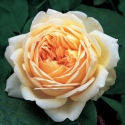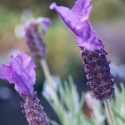Friday 15th November, 2019
Hi
I can't imagine a garden without standards in it. I guess that "
Standards" is nursery speak for plants that are trained or grafted on a taller stem. I often get clients referring to standard roses as "Rose trees" or "Lollipops" all very apt descriptions of them.
Standard roses are just the same as a bush rose except for being grafted on either a 45cm or 80cm stem aka rootstock. I have written often on how these are produced by growing the stock, cutting these into lengths, blinding the stem, achieving roots and growing the standard and finally grafting the roses that we love on top of the stock. We are very proud of our comprehensive range of plants offered as
standards. The rose standards in particular are looking stunning in flower right now in the garden centre. The fragrance as I walk past them in the afternoon, when the heat of the day has them smelling their best, is just breath taking.
But wait...there's more!
Bay trees, Bay Laurel,
Laurus Nobilis, call it what you will, and not just any form but a really good selected clone called Pride of Provence.
Pride of Provence is grown for its attractive leaf shape and colour and makes for a particularly dense form and of course is really responsive to being constantly clipped.... Bays are right up there in robustness and can actually regenerate from quite severe trimming. I have a cone bay in the garden that I have reduced in size several times and it happily leafs back up, although that can take time if we have been really severe.
Bay trees would typically be grown upwards from a cutting being specially selected in its early days with a dominant top bud taking the growing shoot skywards and forced upwards until the desired standards length is reached. I always think that the best height for a standard is around that 100 to 110 cm so that when the head matures it looks in perspective to the height of the overall standard.
The Pride of Provence that we have in the nursery presently are top quality in my opinion with decent length of stem, decent girth and the heads are full and well grown and the price well that is pretty reasonable too at just $129.99 each.
Now if you are a bit of a leaf connoisseur or fancier, then I must tell you about Mandarins as standards as some varieties have really sexy leaves like Corsica no 2. Citrus are usually grafted on trifoliata roostock and standards can be done one of two ways, either by finding the appropriate small grade plants and being grown upwards like the bay trees or by growing the rootstock upwards and then grafting at the top.
'
It seems to me that
citrus are used for topiary or contrived use more in Europe than here and I have never understood why... perhaps it's just less known how good they are for the purpose.
The bottom line is that citrus, including mandarins like the
Corsica No 2, make for pretty awesome standards. I have a rather large, tall one, in
pride of place in the garden which has clipped well for many years.
I have to place a plug for the standard weeping oranges called
Cipo, well they are just awesome, they look amazing and can be grown in pots. They have a growth habit that grows up and cascades. I been growing these in pots and love how they look in the
Doppio's and the oranges are pretty tasty as well. Bonus!
Where would you use standards ???
Plants with height are so incredibly useful in design as they add height to any space and help achieve what I call
layers.
In this generation of much smaller sections, where there isn't a lot of garden space, standards can be the answer for creating the different layers. When privacy is wanted, but space is limited, a hedge on stilts is perfect for providing that all important visual block. Purchasing plants in standard form means that you start with 1.4-1.5 metres of instant height and then you just need to maintain that hedge on stilts look to the height that you want. Often it is just a tad more height, that is wanted, than the standard 1.8 m high wooden fence gives, without getting too tall, which then makes for shading issues.
You also get a space
under the standards that you can use and form quite a cool structured garden.
Standards make excellent pot feature plants. You can grow anything in a pot so whatever takes your fancy, standard Bays,
Roses,
Citrus,
Camellias,
Lavenders,
Loropetalum... it will all depend on whether you want something evergreen or flowery??? The secret with standards in pots is that bigger pots have a longer buffer with watering, so big is best in this case, I also think that the head size needs to be relative to the size of the pot, or is in the region where it will grow and be balanced. My fav shape pots for standards is the classic flowerpot or Doppio where the top is wider that the base but you are limited only by your imagination or budget.
Framing entrance ways is another spot that is a classic place to have standards as their height gives presence.. so either side of doorways or at the garden gate to give a couple of examples.. often along pathways to the house... Roses would have to be a typical choice for this but you could also use any standard. Many of these new sections have a corner garden by the front door and the space is too tiny for a small tree but a standard is the perfect choice as you can maintain its size in an aesthetic way and also have space to again under plant.
PS just a quick extra thought but so many think that all standards have to be maintained to that classic lollipop shape, but no, you could equally clip cones and cubes and rectangular shapes which will give a more contemporary feel... the pleasure of gardening is bringing texture, shapes, colour and form to a pleasing effect... its like being a painter except it constantly grows, evolves and changes.... have fun!
Lavender are the in plant at the nursery at the moment, predominately the English lavender (Angustifolia) varieties but also Dentata a French variety and a few Spanish (Stoechas) relatives?
Blue Mountain compact variety, striking, deep violet-blue flowers in the summer.
Dilly Dilly has large aromatic grey foliage and long stems of intensely aromatic purple flower heads.
Foveuax Storm grey leaves are off set by dark purple flower heads.
Super large aromatic grey foliage and long stems of intensely aromatic purple flower heads.
Pacific Blue delight the senses with stems of intense blue-mauve flowers in the summer months and aromatic fine grey foliage.
Arabian Night Bright violet blue flowers on long "pickable" stems and an intense perfume
Grosso produces an abundance of long stemmed, dark lavender flower heads, great for drying
Munstead A dwarf, compact form with gray foliage and flowers that carry the true sweet lavender fragrance we all love.
Thumbelina Leigh smallest on the market, this little sweetie will charm you with its aromatic, fine grey-green foliage and dainty stems of deep purple flower heads which smell delicious.
Blue Mountain Alba soft grey foliage and fine spikes of white flowers with just a hint of mauve
Grace Leigh A highly fragrant Lavender with arching silver grey foliage and stems of dainty flowers that have a silver hue toned with soft violet.
Zantedetsias chalice shaped flowers reach above wide, spotted leaves in rich late spring colour. Native to Southern Africa these richly coloured lilies give a lovely tropical feel to your garden. They are happy in containers or garden alike and will look amazing planted en masse. Ensure they have good air circulation and good drainage. Last well in the vase.
Black Jack Crystal Blush Hot Cherry Picasso Jack Olantern
Chilli plants are here, these hot little darlings are not going to last long so don't wait if you are wanting them.
Last call for
Owairaka red Kumara just arrived today these are the last of the supply so grab them before it's too late.
It's a big weekend happening in the gardening world, where will you be?
You can see info about these on our
events page or click the links above to go to their web pages.
I know you wont thank me for saying this but apparently it's just 6 weeks to Christmas and if you are like me and like to get all those projects done before the big day then you had better do some planning and get them sorted...
I like to have the garden looking amazing so that when we set the scene for brekky in the garden, well it has got to be special... If you have a garden to get done or just some gaps to fill then now is absolutely the time to sort them before all that Christmas rush, shopping and so on, happens in earnest.
I keep saying it and will continue to do so but the garden centre looks fabulous with a riot of colour happening and so well worth a look even if you are not buying (sacrebleu!). If you are coming out for a gander, whether by yourself or with friends, be sure to take in the display garden as well. The guys have got it looking pretty tidy otherwise all that remains is to wish you happy gardening and
the best weekend
Cheers
Lloyd, Tony and the Wairere Team














